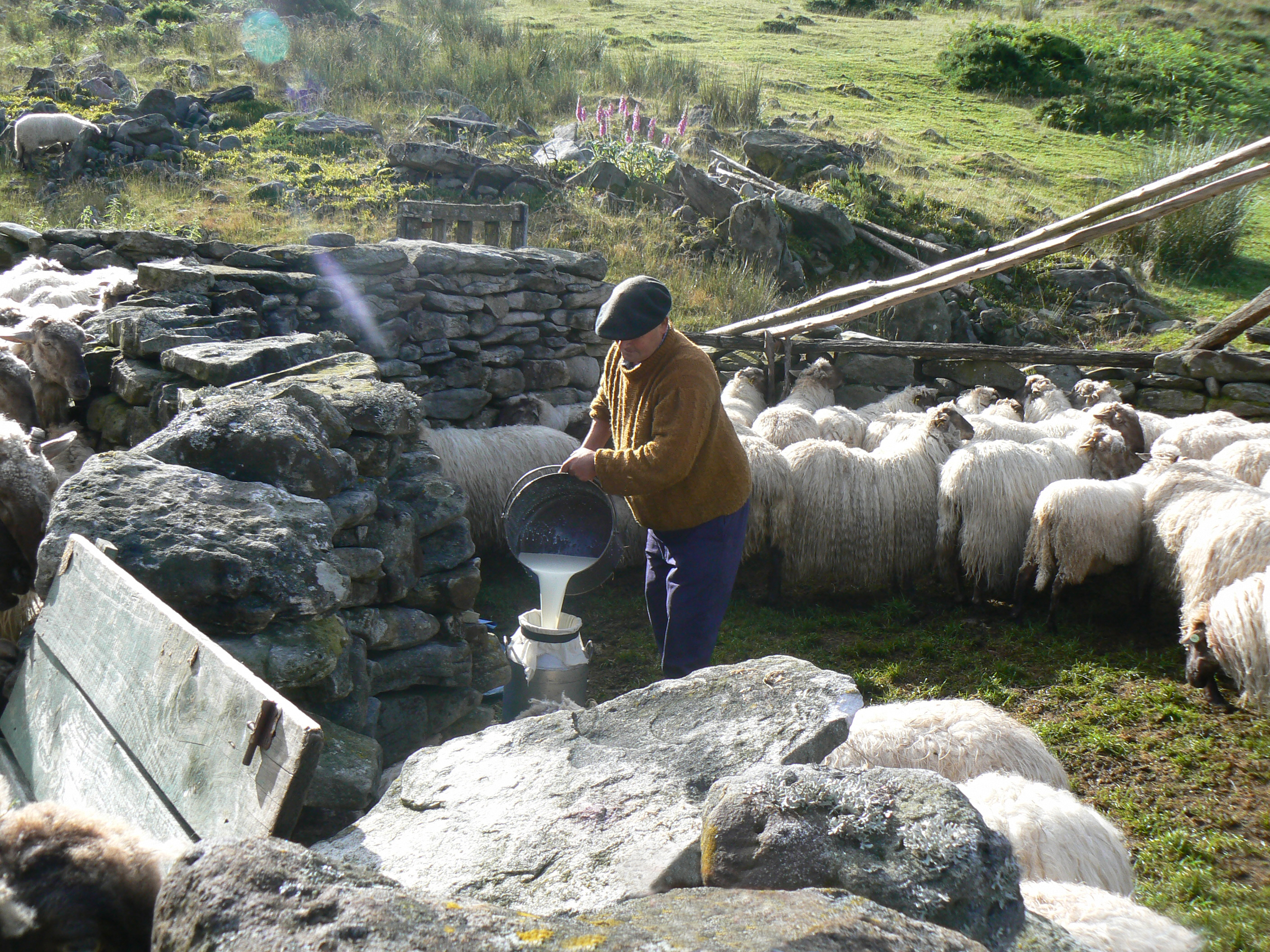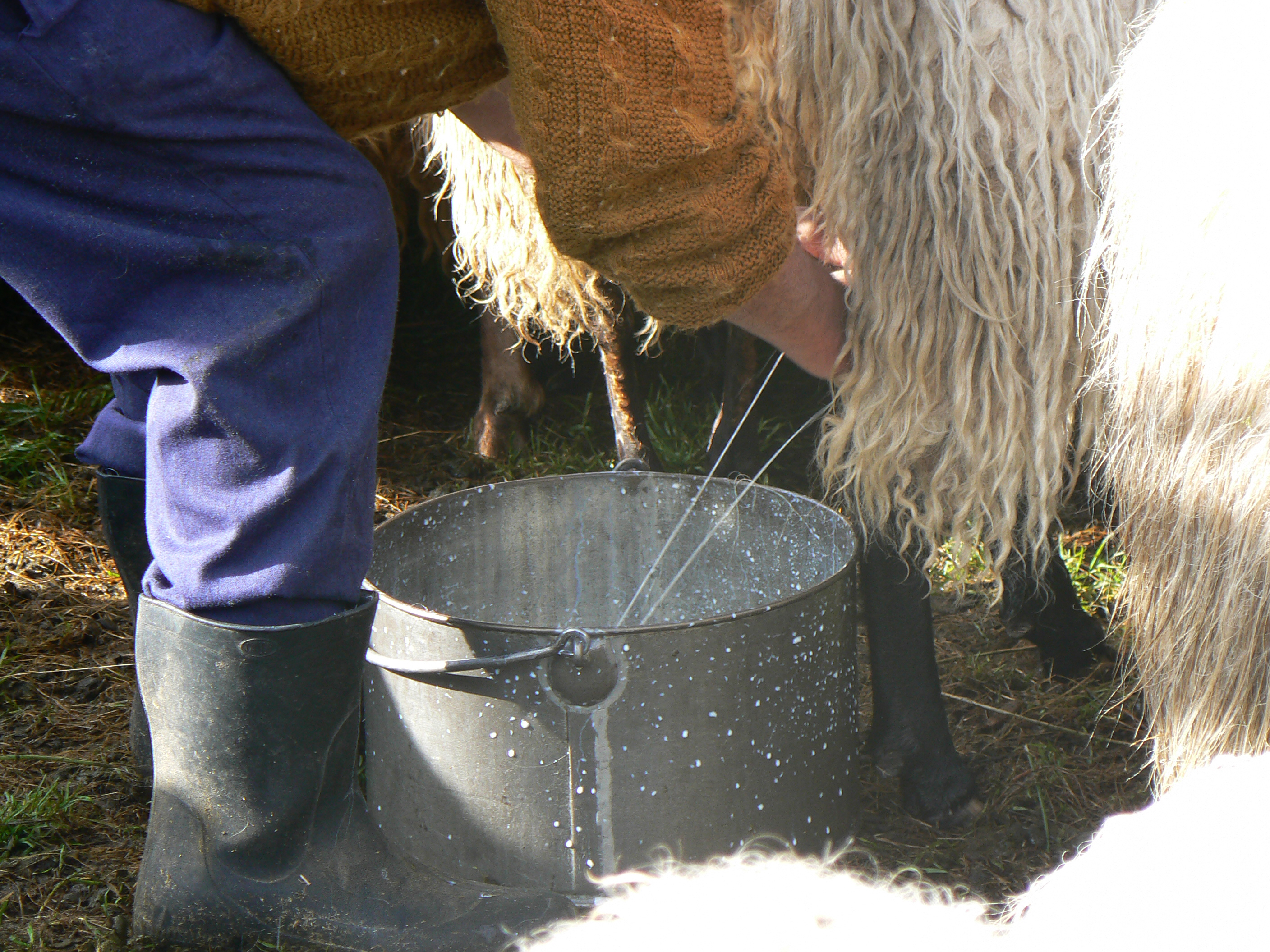Basque ethnography at a glance

Itziar Rotaetxe. Labayru Fundazioa Photographic Archive.
Ubixeta, one of the main refuge areas in Gorbeia, has been home for at least five herds and herders until only a few years ago. Five shepherds spread over four sheds, still standing at present.
Of them all, Jose Ereño, native of Orozko (Bizkaia), is very much alive and kicking. He keeps climbing the mountain with his flock and would, until recently, make cheese using traditional methods, like his father, his father’s father…
The shepherd himself shows us the process of making sheep’s milk cheese, which we describe below:
He gets up early in the morning, gathers his sheep and guides them to the fold for milking, esnea jetzi /esi/, with the help of his inseparable and indispensable dog, named Lagun. Folds are enclosures mostly made of stone walls and slabbed floors to keep the mud away.
He milks his sheep twice a day, in the morning and at sunset, from April to July, approximately. According to him, April and May are the best months in terms of milk quantity, because lambs are usually weaned in March, and there is plenty of pasture. As grass becomes drier, in June and July, milk fat increases, quality improves, and volume decreases.

Itziar Rotaetxe. Labayru Fundazioa Photographic Archive.
A wooden container, called kaikua, would be used in milking in the old days; now Jose uses a bucket as he squats behind each ewe to milk it from the rear. Milk for cheese making should not be boiled, but its temperature at collection maintained. Should it not be used immediately after milking, you might simply warm it up by the heat of the hearth.
Once collected, the milk is poured from the bucket into a canteen, straining it through a piece of cloth. A bunch of nettles would in former times be placed in a funnel, irazkia, made of chestnut wood to strain the milk, the hairs on the nettles retaining the impurities in the milk.
The milk is transferred into a larger cauldron, called abatza, and a curdling agent, legarra or gatzagia, added. Milk-curdling agents are bought at pharmacies today but used to be extracted from the stomach of an unweaned calf, raised on milk and no grass at all. The stomach would be hung to dry from a nail, tied with some coarse thread, by the fireplace. Whenever needed, a little piece would be cut, soaked in water or some lukewarm milk, and the liquid obtained mixed into the milk to be curdled. Not many shepherds use lamb rennet nowadays, although they do recall with nostalgia the characteristic spicy flavour of old-time cheeses.
Having poured the curdling agent in the milk, the mixture is stirred, covered, so it does not cool, and allowed to rest for about three quarters of an hour, more or less. The curdled milk is whipped with a beater, malatsa, made from a holly branch. Having been thoroughly beaten, for air bubbles or eyes not to be formed, the curd is pressed gently and most of the whey, gatzura, drained off. Whey was customarily fed to pigs, which were taken to the mountain to be fattened during the cheese-making season.
The drained mass, named matoia or mamia, is cut into pieces of desire size and dipped into moulds, gaztai-otzarak, previously lined with two strips of cloth, in the shape of a cross. Jose says the cloth helps hoop the curds into their final shape. A wooden knife and cheese baskets made of chestnut wood would be used in the past, he recalls. Jose uses a metal knife and baskets now, bought in Villarreal more than fifty years ago, like almost all his utensils, as he proudly tells us.
Moulds are then placed in the press. Jose’s is a rather rudimentary press which can hold five cheeses at a time, with heavy stones, hanging from strings, pressure being applied on the curds to remove any remnant whey and mould them into the desired shape. Moulds are kept in the press for around twelve hours. Cheeses made in the evening batch are removed from their moulds the following morning, and those from morning in the evening.
Curds might be salted before they are moulded; alternatively, hard-pressed cheeses are submerged in saltwater brine, or a pinch of salt added to the surface of the finished product.
Pressed and salted cheeses are cured on shelves or on a frame, known as karneroa, consisting of a grill, hanging from the ceiling, with separate wooden strips to drain off the whey. Always in a cool and dry spot, away from draughts and sunlight, as heat causes cheese to bloat.
For about fifteen days they are turned over until the rind yellows, and in about two to three months, cheeses will be matured and ready to taste or buy them.
Itziar Rotaetxe – Popular Cultural Heritage Department – Labayru Fundazioa
Translated by Jaione Bilbao – Ethnography Department – Labayru Fundazioa
References for further information: Family Diet and Livestock Farming and Shepherding, both part of the Ethnographic Atlas of the Basque Country collection.

